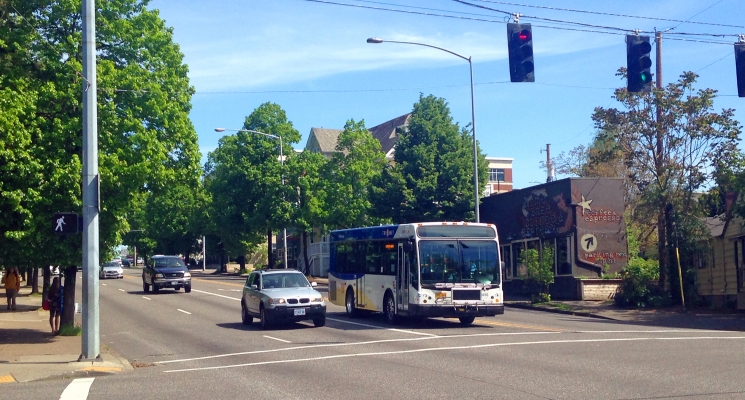NITC researchers evaluate performance of traffic control systems

A new study led by Miguel Figliozzi of Portland State University provides a microscopic evaluation of how two advanced traffic control technologies work together.
Powell Boulevard, an east-west arterial corridor in southeast Portland, Oregon, has been the focus of several research studies by Figliozzi’s TTP research lab. The street is a key route for public transit buses as well as pedestrians and cars, but heavy traffic at peak hours often results in delays.
On Powell there are two systems operating concurrently: a demand-responsive traffic signal system called Sydney Coordinated Adaptive Traffic System (SCATS) and a Transit Signal Priority (TSP) system. The TSP in the Portland metro region is designed to give priority to late buses and to boost transit performance.
In previous studies Figliozzi’s lab has analyzed a multitude of factors on Powell Boulevard including traffic congestion, transit times, air quality and cyclists’ intake of air pollutants, and a before/after evaluation of SCATS.
For this study, the researchers used a novel approach to evaluate how well SCATS and TSP work together by integrating three major data sources and video recordings at individual intersections.
Figliozzi’s team worked closely with TriMet and the City of Portland to integrate bus and traffic signal data: archived SCATS phase log data, bus automatic vehicle location (AVL) and automatic passenger count (APC) data, transit dispatching logs, and when necessary also video recordings along the corridor.
The fine-grained level of data allowed the researchers to focus their attention on developing a methodology and algorithms to study a single intersection at a time, rather than on the overall performance of the corridor as done in past studies.
Although TSP system design and pre-implementation evaluation is important, the results of this study demonstrate that post-implementation performance evaluation is also essential.
When using TSP, bus operators have the ability to request a signal light to turn green early when they are ready to move, or to stay green longer when approaching an intersection. These settings are designed to keep transit running smoothly, but they must be properly maintained in order to work.
TSP systems require continuous monitoring to promptly detect problems. The low numbers of granted TSP phases at some intersections in this study showed that TSP settings were not working properly and that adjustments were needed.
Results also indicate that early green phases generally save passengers more time than green extension phases.
Wei Feng, a recent doctoral graduate from PSU who now works at the Chicago Transit Authority as a performance analyst, co-authored the report. Figliozzi and Feng found that a sizable gap remains between the ideal TSP effectiveness and its actual performance.
They proposed four new performance measures for TSP: frequency, responsiveness, timeliness, and effectiveness.
The TSP performance evaluation results provided worthwhile information for the city and the transit agency to identify potential problems and improvement opportunities for Portland’s TSP system.
The algorithms and performance measures are general and can be applied to other corridors where TSP is implemented (with or without SCATS or adaptive traffic signal control).
For more information about this project, visit the project page or download the final report. It will also be published in the forthcoming 2015 Transportation Research Record.
